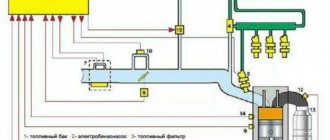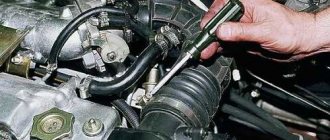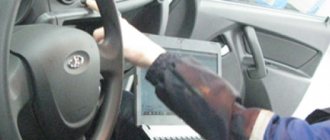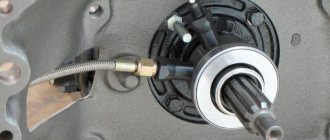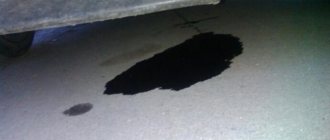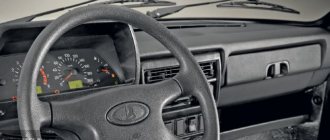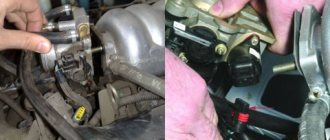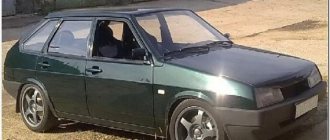Description of the problem
When starting the engine, the speed rises to approximately 1500 RPM at idle. After the engine warms up, they drop to approximately 650-950 RPM, which is the norm. If after warming up the speed remains at the same level, then the engine is not working correctly.
The second option, when a defect occurs, is that the car does not fall when the gas is released while driving, that is, when braking with the engine and coasting. In this case, the speed seems to “freeze” at a level above 1000 RPM until the car comes to a complete stop, although in working cars it should fall below the specified mark.
Determining that a car is running at high speeds is quite simple. If the car's dashboard is equipped with a tachometer, then the increased speed is displayed on it. In the case where there is no tachometer, the increased speed can be determined by the sound of the engine. The greater their number, the higher the tonality and louder the sound of the engine.
Floating speed
In addition to slowly falling revs, car enthusiasts may encounter a phenomenon called floating revs, when they drop and then rise sharply. The reason is excessive air supply into the system, which causes the engine to spin up to 2 thousand revolutions at idle.
This often happens in cars that have a fuel injection sensor. It calculates how much air the mixture needs. When its operation is disrupted, different amounts of oxygen are supplied at different times, as a result, speed jumps are observed approximately every 3 seconds.
Faced with a similar phenomenon, the same computer diagnostics will be a prerequisite. It is very important that this and all subsequent work is carried out by experienced, qualified specialists. By contacting a service that does not specialize in breakdowns of this kind, you may be faced with the need to carry out an expensive overhaul of the engine ahead of time.
Main reasons
The reasons that the speed of the power unit does not decrease differ for cars with injection and carburetor engines.
On carburetor engines
In cars equipped with carburetors, it is this unit that is responsible for preparing and supplying the air-fuel mixture to the combustion chambers. Most often, problems with high speeds are associated with an over-enrichment of the fuel-air mixture, but other causes of malfunction may also occur.
The effect of increased speed can be caused by the following problems.
- Incorrect operation of the throttle valve responsible for the air supply. If the damper, after releasing gas or warming up the engine, cannot close tightly, and a gap forms in it, then an enriched fuel-air mixture enters the engine.
- Open suction. Choke is a control knob for adjusting the air damper, which is responsible for the flow of air into the carburetor. With its help, you can enrich the fuel-air mixture with air. If the suction is not working correctly, the mixture becomes over-enriched with air.
- Needle valve position. In this case, the incorrect dose of fuel will enter the combustion chamber. A malfunction of the needle valve can manifest itself in different ways, including the absence of a drop in speed.
- Incorrect idle speed adjustment. This problem is often encountered by car owners who have changed or repaired the carburetor.
- A fairly rare cause is a burnt-out cylinder head gasket. The problem is manifested not only by increased engine speeds, but also by the appearance of white smoke from the engine compartment.
On injection engines
For cars equipped with injection engines, the range of reasons for increased speed is wider. This is due to the fact that such cars have many more electronic devices and sensors that are responsible for transmitting information to the electronic control unit that regulates engine speed. Therefore, disturbances in engine operation can be associated with both mechanical damage and malfunction of electronic systems.
The reason for the increased speed of injection engines may be one of the following problems.
- Incorrect operation or failure of the coolant temperature control sensor. With such a malfunction, the engine constantly operates in warm-up mode, since the ECU (electronic control unit) does not receive information from the sensor that the engine is already warmed up. As mentioned above, in this mode the engine speed is increased.
- Failure of the mass fuel flow sensor (MAF), which is also called the idle speed sensor. A malfunction of the mass air flow sensor can manifest itself in different ways - a loss of speed or an increase in speed. In the latter case, the engine also goes into constant warm-up mode.
- Throttle position sensor malfunction. In this case, a sensor malfunction may be perceived by the ECU as information about an open throttle valve. Then the control unit gives a command to increase the speed.
Also, the reasons for the increased speed of injection engines can be associated with mechanical damage.
- Broken throttle return spring.
- Sticking throttle cable.
- Damage to the injector gaskets.
Injector system
If your car has an injection system, there may be many more reasons for high idle speeds. Here, both mechanical elements and electronic devices responsible for adjusting the idle speed can fail.
The main injector malfunctions include:
- Incorrect operation of the temperature sensor installed in the cooling system. Incorrectly received data from this device causes the electronics to recognize the engine as cold and work to warm it up, thereby maintaining high speeds necessary to reach operating temperature. Overheating can often occur, which leads to more serious damage, including major engine repairs. The same effect is possible if the idle speed control is not operating correctly.
- The throttle control cable may become stuck. The higher the mileage of the car, the higher the risk of encountering a similar problem.
- The electronic XX operation sensor often malfunctions, then the speed will either increase or disappear altogether.
- The spring that brings the throttle valve to its original closed position is not functioning properly, is jumping off, or is being stretched too far.
- Too much air enters the fuel combustion chamber due to poor quality or leaky gaskets. It is necessary to carefully check the seals of the manifold and injectors.
- And the simplest reason is usually the incorrect placement of the mat after a visit to a car wash or dry cleaning of the interior. It is often inaccurately placed under the accelerator pedal, which leads to the appearance of improper engine operation.
If the car is oversaturated with various electronics and all the work is based on the correct functioning of the sensors, one of them may well become a problem. It will supply incorrect data to the computer, and as a result, the speed will not drop. You will most likely not be able to detect the problem on your own.
It is necessary to contact a car service for computer diagnostics. The task is best handled by specialists working at a service center that specializes in repairing a specific brand of car. If the diagnosis is carried out on time, then it is quite possible to get away with simply replacing the sensor.
You shouldn’t delay repairs, because a supersaturated mixture has a bad effect on engine performance and significantly shortens its service life.
What to do
To solve a problem, you need to diagnose it. On cars equipped with carburetor engines, faults are consistently checked and corrected.
- Incomplete closing of the throttle valve most often occurs due to the formation of carbon deposits from combustion products. In this case, you just need to clean it with carb cleaner. If the throttle valve does not close completely due to a chip or crack, it will need to be replaced.
- A suction malfunction can be eliminated by lubricating the cable and the air damper drive.
- The problem of the needle valve is solved by replacing the part.
- An incorrectly adjusted idle speed can be corrected by adjusting it correctly.
- The blown cylinder head gasket is replaced with a new one.
Solving problems with electronic sensors of injection engines is almost always solved by replacing them. Their malfunction is manifested by the appearance of the Check Engine message; after diagnostics with a scanner, you can receive an error code indicating a specific problem. You can also use a multimeter in ohmmeter mode to diagnose sensor faults.
How to avoid the problem
If all the parts and components of the car are in order, then the problem for cars equipped with fuel injection may lie in the ECU firmware. It is the control unit that regulates engine speed and the composition of the air-fuel mixture entering the cylinders. To avoid the problem of maintaining high speeds in the future after releasing the gas or warming up the engine, you can reflash the electronic control unit.
Another reason that the speed is maintained while driving may be the mat sticking behind the gas pedal. In this case, the accelerator pedal does not go down completely, which leads to excessive enrichment of the fuel-air mixture. To prevent the problem, you just need to adjust the rug.
Electronics failures
Checking the engine idle speed control
After replacing the idle air regulator, it must be “registered” i.e. enter its parameters into the ECU memory.
The idle air control (IAC) is a stepper motor (solenoid) powered by pulse signals supplied. It works in a similar way to the screw for adjusting the amount of mixture in the carburetor - when the valve extends, it closes the fuel channel, and when it moves back, it opens it. It often happens that the regulator core simply jams and it stops responding to ECU signals. Moreover, you can damage the idle air regulator even in the store when purchasing it - by trying to turn or press the valve needle with your hands. If after replacing the idle speed sensor (regulator) there are high speeds, then most likely the problem is either in the ECU or in the mass air flow sensor - all the elements that make up the power system work in interaction, and diagnostics need to be carried out. It is quite possible that you will have to “register” a new regulator - that is, enter its parameters into the ECU memory.
temperature sensor
This sensor can also affect the engine fuel system. By issuing an incorrect signal (corresponding to a low temperature) to the ECU, it will cause the controller to give a signal to other elements of the fuel system (including injectors) that the mixture is enriched. An incorrect sensor signal will result in idle speeds exceeding 1000 min-1.
Mass air flow sensor
The mass air flow sensor directly affects the quality and quantity of the mixture supplied to the cylinders - after all, the ECU “knows” about its composition thanks to this (and some other) sensors. In conclusion, if your car’s engine has increased idle speed for no reason, first look for the cause in possible jamming of the fuel system mechanisms - after all, they are the ones who are primarily exposed to various contaminants, and for electronic components, power surges or short circuits are much more dangerous.
Hello, dear friends! When operating their car, almost every driver faces certain difficulties and problems. For some, for others, antifreeze is boiling, and for others, the engine speed does not drop at all when idling. It is the latter situation that we will talk about today.
This is a widespread malfunction in which the engine constantly keeps revving. Leaving the engine at idle (idle), the tachometer needle still does not want to go down.
Similar situations occur in almost everyone who has an injector and carburetor, diesel and gasoline internal combustion engines under the hood. However, the reasons for injectors and carburetors are different. Let's take a closer look at them.
